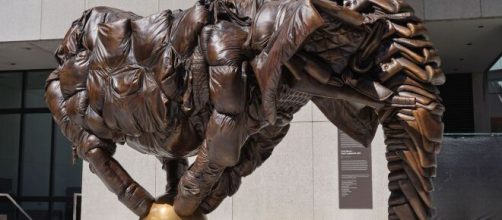At first, graffiti spray-painted on the newly installed sculpture fronting the Art Gallery of Ontario in Toronto seemed a straightforward case of vandalism. The vandal was spotted in the act and charged with "mischief-damage property under $5,000."
The sculpture, called "Couch Monster," owes its title to the materials used – discarded leather couches. The artist, Brian Jungen, portrayed an elephant balancing its bulk on a small ball as an outcry against forcing animals to perform.
But that was not the end of the story. Anti-Semitic graffiti was found at the front of the sculpture, and Toronto's Hate Crime Unit tagged the crime "hate-motivated."
The Toronto News said this is only the latest incident involving anti-Semitic graffiti in Toronto.
Local police surveillance cameras also showed two men spraying anti-Semitic graffiti in three locations last month.
Jew-hating on the rise
Canada, of course, isn't alone in this. Last year, anti-Semitic graffiti was spray-painted on the Florida Holocaust Museum with a swastika and the words "Jews are guilty." And according to the Anti-Defamation League, the number of Jew-hating acts have increased throughout the U.S. An annual audit indicates 2,717 incidents last year – the largest number since ADL began tracking in 1979.
Such attacks also occurred outside the U.S. Last week, French President Emanuel Macron, speaking on the 80th anniversary of Jewish deportations this week, decried anti-Semitism in his country.
"We have not finished with anti-Semitism," he said. "It is still there - stronger and more rampant."
Art takes a hit
The public sculpture has been a handy place for vandals to make their anti-Jewish feelings known. While the elephant statue in Toronto is the latest example, in France, an anti-Semitic attack on Anish Kapoor's sculpture occurred as early as 2015 at the Château de Versailles. At the time, French Culture Minister Fleur Pellerin called it a "fascist vision."
It's been said that former American president Donald Trump's grievance politicking is to blame for the rise of hate crimes in the U.S.
But when it comes to vandalizing artworks, the supposed reasons why fall apart. As noted in my last column, Noah Charney, a specialized in art crime, contends that if vandals have a plan, it usually falls to sexualized art.
Charney's view is far-fetched when you consider that the decidedly staid "Mona Lisa" has been vandalized five times. Art News magazine's theory is also full of holes when it says that vandals feel left out of the "elite world." The frequently vandalized Mona Lisa is without mystery, unless you count her secret smile.
But wait, a theory I offered – that vandalizing art is a form of art criticism – also breaks down. I didn't consider all the graffiti-bearing messages like "The Jews are guilty" written on the Florida Holocaust Museum.
So. this is me revising my view. Vandalism against art may be driven not only by those disaffected by art, but also by those with hate in their hearts toward people unlike them.
How else to explain the action of Paul Cote, the 53-old man who damaged the elephant sculpture in Toronto with an as yet unreported message that the Hate Crime Unit has called "hate-motivated."
As a Jew, I identify with the elephant balancing on a ball as I try to take as little space as possible from the Paul Cotes of the world.


